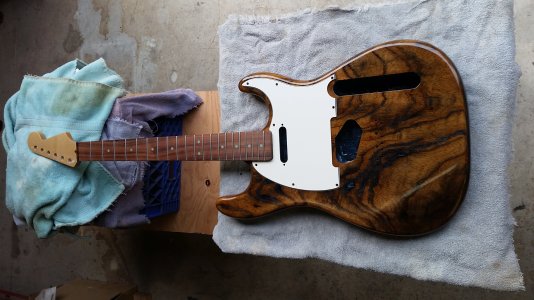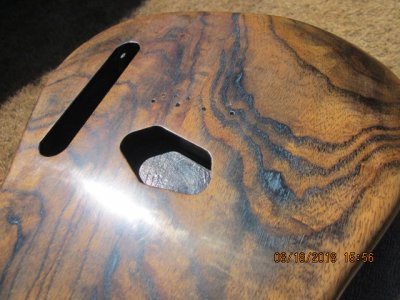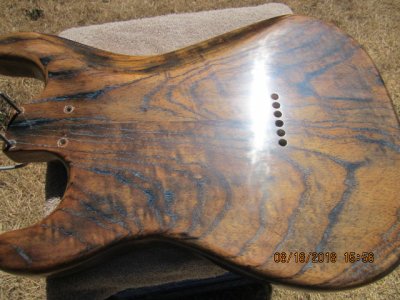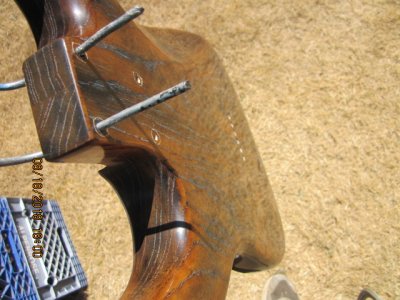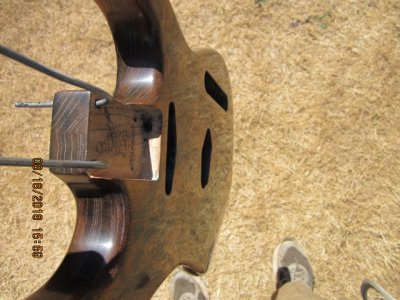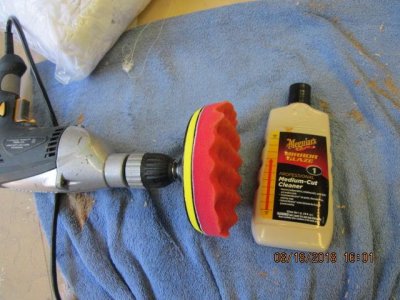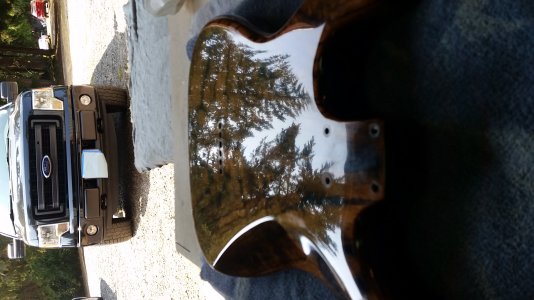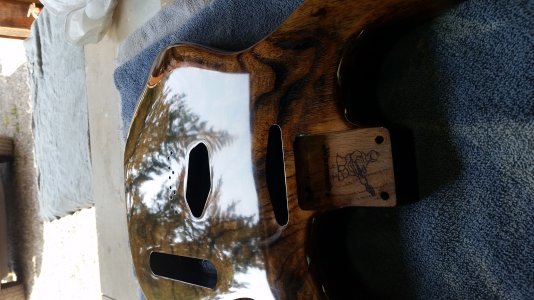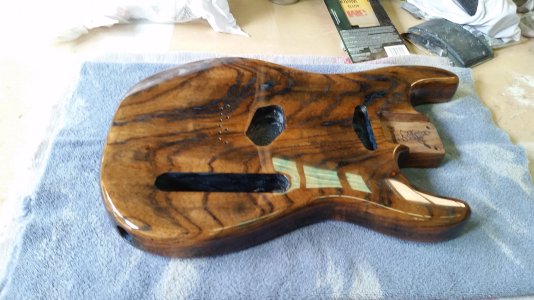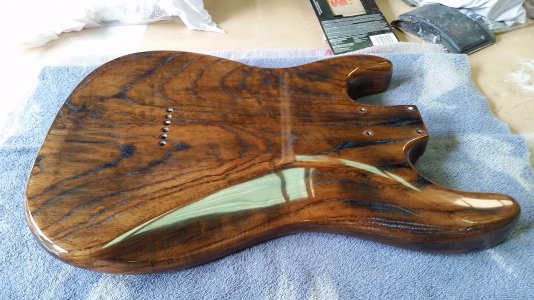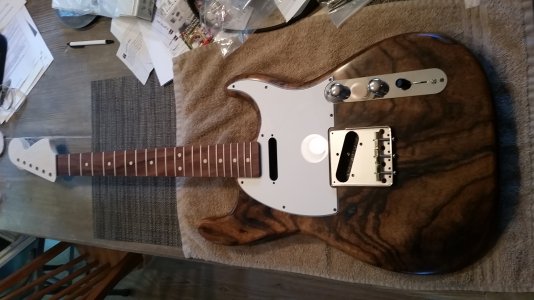Mr. Neutron
Junior Member
- Messages
- 85
Hey, All!
I apologize if this has been covered before here. I did indeed do some searching in the DIY Finishing forum, but couldn't find a sorta "Buffing Spray Poly For Total Boneheads" detailed type of post. It may be here; I just couldn't find it. I've been watching videos and looking at articles I googled. Sigh..... Lots of kinda conflicting info out there. Kinda like bung holes, everybody has their own opinions...... ??? :icon_scratch: :dontknow: To further confuse me, it seems like not a lot of folks use the rattle can version of Minwax's polyurethane, but I hoped a lot of the process for buffing those finishes would be applicable to the spray on stuff......
I have around 7 kinda light coats of Minwax clear gloss spray on poly on my guitar body. I have actually sprayed a tiny bit more on all side edges, corners, and curved portions of the guitar, in an effort to prevent buffing through the topcoat. I had planned on waiting for a minimum of 4 weeks curing time before I even look at the body again. But then I read a helpful post in an old thread (October, 2011) entitled "Poly vs Nitro". In this thread, DMRACO said in post #7:
Next, I read this article ( https://baileylineroad.com/flawlessly-finish-wood-with-correct-sanding-power-tool/ ) where the guy recommends buffing after 24 hours.
So, maybe I better get on this a little sooner than I thought?
Can anyone please possibly detail their procedure for this?
How do you deal with the tight spots around & inside the "horns"? Done by hand? Any pointers for that?
I had figured on hitting the body with a little 0000 steel wool in a few days to get rid of a little bit of the airborne dust that inevitably settle on it as it dries.
And then waiting a long while before very lightly level wet sanding the flat surfaces with, say, 800 or 1000 grit .
After that, I had planned on lightly wet sanding with 1500 grit, and then 2000 grit.
I figured next I would try a "medium grade" of fine rubbing compound with a sponge pad using my drill (don't have a random orbital sander).
Follow that by something finer on another sponge pad, and then finally some polishing compound.
Is this a decent "process"? If not, what should a person do differently? And when to even begin it?
Again, I apologize for the long post, and so many questions. It just seems the more I read and watch, the tougher time I have of figuring out a course of action for myself. My background (machinist) tends to be from a metalworking perspective, so my experiences to draw from may not be very relevant for wood stuff. I did prep and paint a 510 Datsun 35 yrs. ago, so I have a slight grasp of body work principles. But again, not much experience with wood. My attempts at Brush on poly sucked badly. My Tru Oil finishes weren't near as great as what I've seen others do; ditto for my wipe on poly. So advice and help are definitely welcomed here.
Thanks!
I apologize if this has been covered before here. I did indeed do some searching in the DIY Finishing forum, but couldn't find a sorta "Buffing Spray Poly For Total Boneheads" detailed type of post. It may be here; I just couldn't find it. I've been watching videos and looking at articles I googled. Sigh..... Lots of kinda conflicting info out there. Kinda like bung holes, everybody has their own opinions...... ??? :icon_scratch: :dontknow: To further confuse me, it seems like not a lot of folks use the rattle can version of Minwax's polyurethane, but I hoped a lot of the process for buffing those finishes would be applicable to the spray on stuff......
I have around 7 kinda light coats of Minwax clear gloss spray on poly on my guitar body. I have actually sprayed a tiny bit more on all side edges, corners, and curved portions of the guitar, in an effort to prevent buffing through the topcoat. I had planned on waiting for a minimum of 4 weeks curing time before I even look at the body again. But then I read a helpful post in an old thread (October, 2011) entitled "Poly vs Nitro". In this thread, DMRACO said in post #7:
I will say this, concerning the ease of poly. While NOT instrument grade, I have used MINWAX spray poly on three builds, nitro on the other three. My very 1st warmoth build, a maple tele is over 15 years old and I used 5-6 coats of minwax spray poly. Looks FANTASTIC!!!!. Held up well too.
The only issue is it is a bitch to rapair if it does get messed up. On a recent build I sanded thru when finish sanding. As much as I tried to blend, I ended up refinishing the entire side of the guitar!!!
My Zebra strat I used satin poly spray, looking and feels like a natural wood finish.
My next build will be a double cut gibson replica...nitro all the way.
I have to ask if you are spraying your self? Another difference is CURE time. Poly is good to go in about 72 hours depending on how many coats and humidity. If you wait longer, you will have a finish that is hard as nails and almost impossible to buff. Nitro can take weeks to full gas/cure. Sand to soon and you will gum the finish.
Next, I read this article ( https://baileylineroad.com/flawlessly-finish-wood-with-correct-sanding-power-tool/ ) where the guy recommends buffing after 24 hours.
So, maybe I better get on this a little sooner than I thought?
Can anyone please possibly detail their procedure for this?
How do you deal with the tight spots around & inside the "horns"? Done by hand? Any pointers for that?
I had figured on hitting the body with a little 0000 steel wool in a few days to get rid of a little bit of the airborne dust that inevitably settle on it as it dries.
And then waiting a long while before very lightly level wet sanding the flat surfaces with, say, 800 or 1000 grit .
After that, I had planned on lightly wet sanding with 1500 grit, and then 2000 grit.
I figured next I would try a "medium grade" of fine rubbing compound with a sponge pad using my drill (don't have a random orbital sander).
Follow that by something finer on another sponge pad, and then finally some polishing compound.
Is this a decent "process"? If not, what should a person do differently? And when to even begin it?
Again, I apologize for the long post, and so many questions. It just seems the more I read and watch, the tougher time I have of figuring out a course of action for myself. My background (machinist) tends to be from a metalworking perspective, so my experiences to draw from may not be very relevant for wood stuff. I did prep and paint a 510 Datsun 35 yrs. ago, so I have a slight grasp of body work principles. But again, not much experience with wood. My attempts at Brush on poly sucked badly. My Tru Oil finishes weren't near as great as what I've seen others do; ditto for my wipe on poly. So advice and help are definitely welcomed here.
Thanks!



